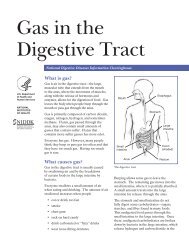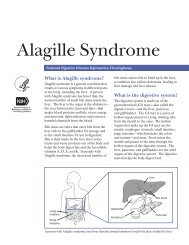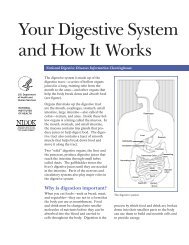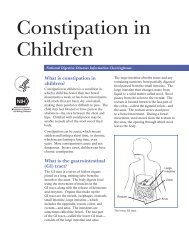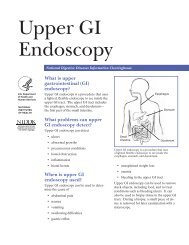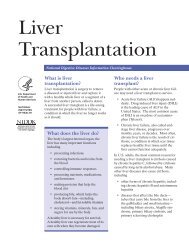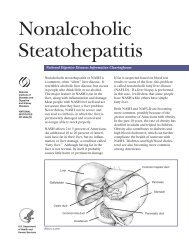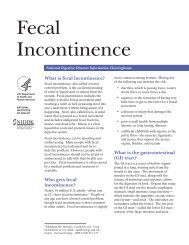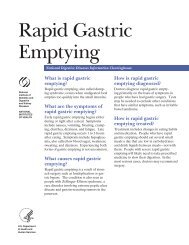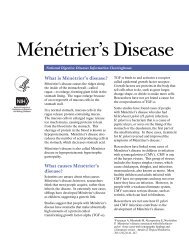Inguinal Hernia - National Digestive Diseases Information ...
Inguinal Hernia - National Digestive Diseases Information ...
Inguinal Hernia - National Digestive Diseases Information ...
You also want an ePaper? Increase the reach of your titles
YUMPU automatically turns print PDFs into web optimized ePapers that Google loves.
<strong>Inguinal</strong> <strong>Hernia</strong><br />
<strong>National</strong> <strong>Digestive</strong> <strong>Diseases</strong> <strong>Information</strong> Clearinghouse<br />
What is an inguinal hernia<br />
An inguinal hernia happens when contents<br />
of the abdomen—usually fat or part of the<br />
small intestine—bulge through a weak area<br />
in the lower abdominal wall. The abdomen<br />
is the area between the chest and the hips.<br />
The area of the lower abdominal wall is also<br />
called the inguinal or groin region.<br />
Two types of inguinal hernias are<br />
• indirect inguinal hernias, which are<br />
caused by a defect in the abdominal wall<br />
that is congenital, or present at birth<br />
• direct inguinal hernias, which usually<br />
occur only in male adults and are<br />
caused by a weakness in the muscles of<br />
the abdominal wall that develops over<br />
time<br />
<strong>Inguinal</strong> hernias occur at the inguinal canal<br />
in the groin region.<br />
What is the inguinal canal<br />
The inguinal canal is a passage through the<br />
lower abdominal wall. People have two<br />
inguinal canals—one on each side of the<br />
lower abdomen. In males, the spermatic<br />
cords pass through the inguinal canals and<br />
connect to the testicles in the scrotum—the<br />
sac around the testicles. The spermatic cords<br />
contain blood vessels, nerves, and a duct,<br />
called the spermatic duct, that carries sperm<br />
from the testicles to the penis. In females,<br />
the round ligaments, which support the<br />
uterus, pass through the inguinal canals.<br />
What causes inguinal<br />
hernias<br />
The cause of inguinal hernias depends on the<br />
type of inguinal hernia.<br />
Indirect inguinal hernias. A defect in the<br />
abdominal wall that is present at birth causes<br />
an indirect inguinal hernia.<br />
During the development of the fetus in the<br />
womb, the lining of the abdominal cavity<br />
forms and extends into the inguinal canal.<br />
In males, the spermatic cord and testicles<br />
descend out from inside the abdomen<br />
and through the abdominal lining to the<br />
scrotum through the inguinal canal. Next,<br />
the abdominal lining usually closes off the<br />
entrance to the inguinal canal a few weeks<br />
before or after birth. In females, the ovaries<br />
do not descend out from inside the abdomen,<br />
and the abdominal lining usually closes a<br />
couple of months before birth. 1<br />
Sometimes the lining of the abdomen does<br />
not close as it should, leaving an opening<br />
in the abdominal wall at the upper part of<br />
the inguinal canal. Fat or part of the small<br />
intestine may slide into the inguinal canal<br />
through this opening, causing a hernia. In<br />
females, the ovaries may also slide into the<br />
inguinal canal and cause a hernia.
Indirect hernias are the most common<br />
type of inguinal hernia. 2 Indirect inguinal<br />
hernias may appear in 2 to 3 percent of<br />
male children; however, they are much less<br />
common in female children, occurring in less<br />
than 1 percent. 3<br />
Small intestine<br />
Scrotum<br />
Indirect inguinal hernia in a male<br />
<strong>Inguinal</strong> canal<br />
Spermatic<br />
cord<br />
Testicle<br />
Direct inguinal hernias. Direct inguinal<br />
hernias usually occur only in male adults<br />
as aging and stress or strain weaken the<br />
abdominal muscles around the inguinal<br />
canal. Previous surgery in the lower<br />
abdomen can also weaken the abdominal<br />
muscles.<br />
Females rarely form this type of inguinal<br />
hernia. In females, the broad ligament of the<br />
uterus acts as an additional barrier behind<br />
the muscle layer of the lower abdominal wall.<br />
The broad ligament of the uterus is a sheet<br />
of tissue that supports the uterus and other<br />
reproductive organs.<br />
Who is more likely to<br />
develop an inguinal hernia<br />
Males are much more likely to develop<br />
inguinal hernias than females. About<br />
25 percent of males and about 2 percent of<br />
females will develop an inguinal hernia in<br />
their lifetimes. 2 Some people who have an<br />
inguinal hernia on one side will have or will<br />
develop a hernia on the other side.<br />
People of any age can develop inguinal<br />
hernias. Indirect hernias can appear before<br />
age 1 and often appear before age 30;<br />
however, they may appear later in life.<br />
Premature infants have a higher chance<br />
of developing an indirect inguinal hernia.<br />
Direct hernias, which usually only occur in<br />
male adults, are much more common in men<br />
older than age 40 because the muscles of the<br />
abdominal wall weaken with age. 4<br />
People with a family history of inguinal<br />
hernias are more likely to develop inguinal<br />
hernias. Studies also suggest that people<br />
who smoke have an increased risk of inguinal<br />
hernias. 5<br />
2 <strong>Inguinal</strong> <strong>Hernia</strong>
What are the signs and<br />
symptoms of an inguinal<br />
hernia<br />
The first sign of an inguinal hernia is a small<br />
bulge on one or, rarely, on both sides of the<br />
groin—the area just above the groin crease<br />
between the lower abdomen and the thigh.<br />
The bulge may increase in size over time and<br />
usually disappears when lying down.<br />
Other signs and symptoms can include<br />
• discomfort or pain in the groin—<br />
especially when straining, lifting,<br />
coughing, or exercising—that improves<br />
when resting<br />
• feelings such as weakness, heaviness,<br />
burning, or aching in the groin<br />
• a swollen or an enlarged scrotum in<br />
men or boys<br />
Indirect and direct inguinal hernias may slide<br />
in and out of the abdomen into the inguinal<br />
canal. A health care provider can often<br />
move them back into the abdomen with<br />
gentle massage.<br />
What are the complications<br />
of inguinal hernias<br />
<strong>Inguinal</strong> hernias can cause the following<br />
complications:<br />
• Incarceration. An incarcerated hernia<br />
happens when part of the fat or small<br />
intestine from inside the abdomen<br />
becomes stuck in the groin or scrotum<br />
and cannot go back into the abdomen.<br />
A health care provider is unable to<br />
massage the hernia back into the<br />
abdomen.<br />
• Strangulation. When an incarcerated<br />
hernia is not treated, the blood supply<br />
to the small intestine may become<br />
obstructed, causing “strangulation” of<br />
the small intestine. This lack of blood<br />
supply is an emergency situation and<br />
can cause the section of the intestine<br />
to die.<br />
Seek Immediate Care<br />
People who have symptoms of an<br />
incarcerated or a strangulated hernia<br />
should seek emergency medical help<br />
immediately. A strangulated hernia is a<br />
life-threatening condition. Symptoms of<br />
an incarcerated or a strangulated hernia<br />
include<br />
• extreme tenderness or painful<br />
redness in the area of the bulge in<br />
the groin<br />
• sudden pain that worsens quickly<br />
and does not go away<br />
• the inability to have a bowel<br />
movement and pass gas<br />
• nausea and vomiting<br />
• fever<br />
3 <strong>Inguinal</strong> <strong>Hernia</strong>
How are inguinal hernias<br />
diagnosed<br />
A health care provider diagnoses an inguinal<br />
hernia with<br />
• a medical and family history<br />
• a physical exam<br />
• imaging tests, including x rays<br />
Medical and family history. Taking a<br />
medical and family history may help a<br />
health care provider diagnose an inguinal<br />
hernia. Often the symptoms that the patient<br />
describes will be signs of an inguinal hernia.<br />
Physical exam. A physical exam may help<br />
diagnose an inguinal hernia. During a<br />
physical exam, a health care provider usually<br />
examines the patient’s body. The health care<br />
provider may ask the patient to stand and<br />
cough or strain so the health care provider<br />
can feel for a bulge caused by the hernia as it<br />
moves into the groin or scrotum. The health<br />
care provider may gently try to massage the<br />
hernia back into its proper position in the<br />
abdomen.<br />
Imaging tests. A health care provider does<br />
not usually use imaging tests, including<br />
x rays, to diagnose an inguinal hernia unless<br />
he or she<br />
• is trying to diagnose a strangulation or<br />
an incarceration<br />
• cannot feel the inguinal hernia during<br />
a physical exam, especially in patients<br />
who are overweight<br />
• is uncertain if the hernia or another<br />
condition is causing the swelling in the<br />
groin or other symptoms<br />
Specially trained technicians perform<br />
imaging tests at a health care provider’s<br />
office, an outpatient center, or a hospital.<br />
A radiologist—a doctor who specializes in<br />
medical imaging—interprets the images. A<br />
patient does not usually need anesthesia.<br />
Tests may include the following:<br />
• Abdominal x ray. An x ray is a picture<br />
recorded on film or on a computer<br />
using a small amount of radiation.<br />
The patient will lie on a table or stand<br />
during the x ray. The technician<br />
positions the x-ray machine over the<br />
abdominal area. The patient will hold<br />
his or her breath as the technician takes<br />
the picture so that the picture will not<br />
be blurry. The technician may ask the<br />
patient to change position for additional<br />
pictures.<br />
• Computerized tomography (CT) scan.<br />
CT scans use a combination of x rays<br />
and computer technology to create<br />
images. For a CT scan, the technician<br />
may give the patient a solution to<br />
drink and an injection of a special dye,<br />
called contrast medium. A health care<br />
provider injects the contrast medium<br />
into a vein, and the injection will make<br />
the patient feel warm all over for a<br />
minute or two. The contrast medium<br />
allows the health care provider to see<br />
the blood vessels and blood flow on the<br />
x rays. CT scans require the patient to<br />
lie on a table that slides into a tunnelshaped<br />
device where the technician<br />
takes the x rays. A health care provider<br />
may give children a sedative to help<br />
them fall asleep for the test.<br />
• Abdominal ultrasound. Ultrasound<br />
uses a device, called a transducer, that<br />
bounces safe, painless sound waves<br />
off organs to create an image of their<br />
structure.<br />
4 <strong>Inguinal</strong> <strong>Hernia</strong>
How are inguinal hernias<br />
treated<br />
Repair of an inguinal hernia via surgery is<br />
the only treatment for inguinal hernias and<br />
can prevent incarceration and strangulation.<br />
Health care providers recommend surgery<br />
for most people with inguinal hernias and<br />
especially for people with hernias that cause<br />
symptoms. Research suggests that men<br />
with hernias that cause few or no symptoms<br />
may be able to safely delay surgery until<br />
their symptoms increase. 3,6 Men who<br />
delay surgery should watch for symptoms<br />
and see a health care provider regularly.<br />
Health care providers usually recommend<br />
surgery for infants and children to prevent<br />
incarceration. 1 Emergent, or immediate,<br />
surgery is necessary for incarcerated or<br />
strangulated hernias.<br />
A general surgeon—a doctor who specializes<br />
in abdominal surgery—performs hernia<br />
surgery at a hospital or surgery center,<br />
usually on an outpatient basis. Recovery<br />
time varies depending on the size of the<br />
hernia, the technique used, and the age and<br />
health of the person.<br />
<strong>Hernia</strong> surgery is also called herniorrhaphy.<br />
The two main types of surgery for hernias are<br />
• Open hernia repair. During an open<br />
hernia repair, a health care provider<br />
usually gives a patient local anesthesia<br />
in the abdomen with sedation; however,<br />
some patients may have<br />
––<br />
sedation with a spinal block, in<br />
which a health care provider injects<br />
anesthetics around the nerves in the<br />
spine, making the body numb from<br />
the waist down<br />
––<br />
general anesthesia<br />
The surgeon makes an incision in the<br />
groin, moves the hernia back into the<br />
abdomen, and reinforces the abdominal<br />
wall with stitches. Usually the surgeon<br />
also reinforces the weak area with a<br />
synthetic mesh or “screen” to provide<br />
additional support.<br />
• Laparoscopic hernia repair. A<br />
surgeon performs laparoscopic hernia<br />
repair with the patient under general<br />
anesthesia. The surgeon makes several<br />
small, half-inch incisions in the lower<br />
abdomen and inserts a laparoscope—a<br />
thin tube with a tiny video camera<br />
attached. The camera sends a<br />
magnified image from inside the body<br />
to a video monitor, giving the surgeon<br />
a close-up view of the hernia and<br />
surrounding tissue. While watching the<br />
monitor, the surgeon repairs the hernia<br />
using synthetic mesh or “screen.”<br />
People who undergo laparoscopic hernia<br />
repair generally experience a shorter<br />
recovery time than those who have an open<br />
hernia repair. However, the surgeon may<br />
determine that laparoscopy is not the best<br />
option if the hernia is large or if the person<br />
has had previous pelvic surgery.<br />
Most adults experience discomfort and<br />
require pain medication after either an<br />
open hernia repair or a laparoscopic hernia<br />
repair. Intense activity and heavy lifting are<br />
restricted for several weeks. The surgeon<br />
will discuss when a person may safely<br />
return to work. Infants and children also<br />
experience some discomfort; however, they<br />
usually resume normal activities after several<br />
days.<br />
5 <strong>Inguinal</strong> <strong>Hernia</strong>
Surgery to repair an inguinal hernia is quite<br />
safe, and complications are uncommon.<br />
People should contact their health care<br />
provider if any of the following symptoms<br />
appear:<br />
• redness around or drainage from the<br />
incision<br />
• fever<br />
• bleeding from the incision<br />
• pain that is not relieved by medication<br />
or pain that suddenly worsens<br />
Possible long-term complications include<br />
• long-lasting pain in the groin<br />
• recurrence of the hernia, requiring a<br />
second surgery<br />
• damage to nerves near the hernia<br />
How can inguinal hernias<br />
be prevented<br />
People cannot prevent the weakness in<br />
the abdominal wall that causes indirect<br />
inguinal hernias. However, people may<br />
be able to prevent direct inguinal hernias<br />
by maintaining a healthy weight and not<br />
smoking.<br />
People can keep inguinal hernias from<br />
getting worse or keep inguinal hernias from<br />
recurring after surgery by<br />
• avoiding heavy lifting<br />
• using the legs, not the back, when lifting<br />
objects<br />
• preventing constipation and straining<br />
during bowel movements<br />
• maintaining a healthy weight<br />
• not smoking<br />
Eating, Diet, and Nutrition<br />
Researchers have not found that eating, diet,<br />
and nutrition play a role in causing inguinal<br />
hernias. A person with an inguinal hernia<br />
may be able to prevent symptoms by eating<br />
high-fiber foods. Fresh fruits, vegetables,<br />
and whole grains are high in fiber and may<br />
help prevent the constipation and straining<br />
that cause some of the painful symptoms of<br />
a hernia.<br />
The surgeon will provide instructions on<br />
eating, diet, and nutrition after inguinal<br />
hernia surgery. Most people drink liquids<br />
and eat a light diet the day of the operation<br />
and then resume their usual diet the<br />
next day.<br />
Points to Remember<br />
• An inguinal hernia happens when<br />
contents of the abdomen—usually fat<br />
or part of the small intestine—bulge<br />
through a weak area in the lower<br />
abdominal wall.<br />
• A defect in the abdominal wall that<br />
is present at birth causes an indirect<br />
inguinal hernia.<br />
• Direct inguinal hernias usually occur<br />
only in male adults as aging and stress<br />
or strain weaken the abdominal muscles<br />
around the inguinal canal. Females<br />
rarely form this type of inguinal hernia.<br />
• The first sign of an inguinal hernia is a<br />
small bulge on one or, rarely, on both<br />
sides of the groin—the area just above<br />
the groin crease between the lower<br />
abdomen and the thigh.<br />
6 <strong>Inguinal</strong> <strong>Hernia</strong>
• An incarcerated hernia happens when<br />
part of the fat or small intestine from<br />
inside the abdomen becomes stuck in<br />
the groin or scrotum and cannot go back<br />
into the abdomen.<br />
• When an incarcerated hernia is not<br />
treated, the blood supply to the small<br />
intestine may become obstructed,<br />
causing “strangulation” of the small<br />
intestine.<br />
• People who have symptoms of an<br />
incarcerated or a strangulated hernia<br />
should seek emergency medical help<br />
immediately. A strangulated hernia is a<br />
life-threatening condition.<br />
• Repair of an inguinal hernia via surgery<br />
is the only treatment for inguinal<br />
hernias and can prevent incarceration<br />
and strangulation.<br />
Hope through Research<br />
The <strong>National</strong> Institute of Diabetes and<br />
<strong>Digestive</strong> and Kidney <strong>Diseases</strong>’ (NIDDK’s)<br />
Division of <strong>Digestive</strong> <strong>Diseases</strong> and Nutrition<br />
supports basic and clinical research into<br />
digestive and abdominal conditions.<br />
Clinical trials are research studies involving<br />
people. Clinical trials look at safe and<br />
effective new ways to prevent, detect, or<br />
treat disease. Researchers also use clinical<br />
trials to look at other aspects of care, such<br />
as improving the quality of life for people<br />
with chronic illnesses. To learn more about<br />
clinical trials, why they matter, and how to<br />
participate, visit the NIH Clinical Research<br />
Trials and You website at www.nih.gov/health/<br />
clinicaltrials. For information about current<br />
studies, visit www.ClinicalTrials.gov.<br />
References<br />
1. Aiken JJ, Oldham KT. Chapter 38:<br />
<strong>Inguinal</strong> hernias. In: Kleigman RM,<br />
Stanton BF, St. Geme JW, Schor NF,<br />
Behrman RE, eds. Nelson Textbook of<br />
Pediatrics. 19th ed. Philadelphia: Elsevier<br />
Saunders; 2011: 1362–1368.<br />
2. Nicks BA. <strong>Hernia</strong>s. Medscape website.<br />
http://emedicine.medscape.com/<br />
article/775630-overview#aw2aab6b2b3.<br />
Updated April 21, 2014. Accessed<br />
April 23, 2014.<br />
3. Kelly KB, Ponsky TA. Pediatric<br />
abdominal wall defects. Surgical Clinics<br />
of North America. 2013;93(5):1255–1267.<br />
4. Quintas ML, Rodrigues CJ, Yoo JH,<br />
Rodrigues Junior AJ. Age related<br />
changes in the elastic fiber system of the<br />
interfoveolar ligament. Revista do Hospital<br />
das Clínicas. 2000;55(3):83–86.<br />
5. Simons MP, Aufenacker T, Bay-Nielsen<br />
M, et al. European <strong>Hernia</strong> Society<br />
guidelines on the treatment of inguinal<br />
hernia in adult patients. <strong>Hernia</strong>.<br />
2009;13(4):343–403.<br />
6. Jeyarajah R, Harford WV. Chapter<br />
24: Abdominal hernias and gastric<br />
volvulus. In: Feldman M, Friedman LS,<br />
Brandt LJ, eds. Sleisenger and Fordtran’s<br />
Gastrointestinal and Liver Disease:<br />
Pathophysiology, Diagnosis, Management.<br />
9th ed. Philadelphia: Elsevier Saunders;<br />
2010: 379–395.<br />
7 <strong>Inguinal</strong> <strong>Hernia</strong>
For More <strong>Information</strong><br />
American Academy of Family Physicians<br />
P.O. Box 11210<br />
Shawnee Mission, KS 66207–1210<br />
Phone: 1–800–274–2237 or 913–906–6000<br />
Internet: www.aafp.org<br />
American College of Surgeons<br />
633 North Saint Clair Street<br />
Chicago, IL 60611–3211<br />
Phone: 1–800–621–4111 or 312–202–5000<br />
Fax: 312–202–5001<br />
Email: postmaster@facs.org<br />
Internet: www.facs.org<br />
American Pediatric Surgical Association<br />
111 Deer Lake Road, Suite 100<br />
Deerfield, IL 60015<br />
Phone: 847–480–9576<br />
Fax: 847–480–9282<br />
Email: eapsa@eapsa.org<br />
Internet: www.eapsa.org<br />
Acknowledgments<br />
Publications produced by the Clearinghouse<br />
are carefully reviewed by both NIDDK<br />
scientists and outside experts. This<br />
publication was reviewed by Michael G. Sarr,<br />
M.D., Mayo Clinic.<br />
You may also find additional information about this<br />
topic by visiting MedlinePlus at www.medlineplus.gov.<br />
This publication may contain information about<br />
medications and, when taken as prescribed,<br />
the conditions they treat. When prepared, this<br />
publication included the most current information<br />
available. For updates or for questions about<br />
any medications, contact the U.S. Food and Drug<br />
Administration toll-free at 1–888–INFO–FDA<br />
(1–888–463–6332) or visit www.fda.gov. Consult your<br />
health care provider for more information.<br />
<strong>National</strong> <strong>Digestive</strong> <strong>Diseases</strong><br />
<strong>Information</strong> Clearinghouse<br />
2 <strong>Information</strong> Way<br />
Bethesda, MD 20892–3570<br />
Phone: 1–800–891–5389<br />
TTY: 1–866–569–1162<br />
Fax: 703–738–4929<br />
Email: nddic@info.niddk.nih.gov<br />
Internet: www.digestive.niddk.nih.gov<br />
The <strong>National</strong> <strong>Digestive</strong> <strong>Diseases</strong> <strong>Information</strong><br />
Clearinghouse (NDDIC) is a service of the<br />
<strong>National</strong> Institute of Diabetes and <strong>Digestive</strong><br />
and Kidney <strong>Diseases</strong> (NIDDK). The<br />
NIDDK is part of the <strong>National</strong> Institutes of<br />
Health of the U.S. Department of Health<br />
and Human Services. Established in 1980,<br />
the Clearinghouse provides information<br />
about digestive diseases to people with<br />
digestive disorders and to their families,<br />
health care professionals, and the public.<br />
The NDDIC answers inquiries, develops and<br />
distributes publications, and works closely<br />
with professional and patient organizations<br />
and Government agencies to coordinate<br />
resources about digestive diseases.<br />
This publication is not copyrighted. The Clearinghouse<br />
encourages users of this publication to duplicate and<br />
distribute as many copies as desired.<br />
This publication is available at<br />
www.digestive.niddk.nih.gov.<br />
NIH Publication No. 14–4634<br />
May 2014<br />
The NIDDK prints on recycled paper with bio-based ink.



